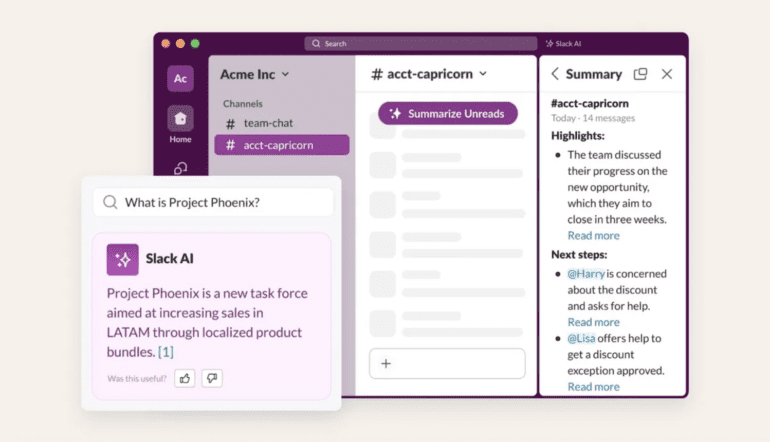TL;DR:
- Slack introduces AI-driven features, Slack AI and Slack Lists.
- Slack AI offers channel recaps, thread summaries, and search answers.
- Slack Lists enables task tracking, collaboration, and integration with Workflow Builder.
- Workflow Builder gets an upgrade and is available for paid users.
- Zoom also unveils a similar AI feature for meeting summaries.
Main AI News:
In an era where technology continually reshapes the workspace, Slack is spearheading innovation with the integration of an AI tool designed to streamline and synthesize work-related discussions. As the digital landscape evolves, the need for efficient communication and productivity enhancements becomes increasingly crucial. Slack’s recent unveiling of Slack AI and Slack Lists represents a significant stride towards optimizing workplace efficiency.
Slack’s initial foray into the realm of AI-driven chatbot technology, announced earlier this year, set the stage for this groundbreaking development. Now, as we approach the winter season, Slack is poised to test these transformative features, with plans to release them on a broader scale in the near future.
Slack AI, the latest addition to the platform, promises to revolutionize in-app capabilities. It will introduce channel recaps, offering succinct summaries of crucial highlights and one-click thread summaries, providing users with the essence of lengthy discussions at their fingertips. However, one of the most intriguing facets of Slack AI is its search answers feature, which enables users to pose questions and receive comprehensive responses. This includes related messages, files, channels, and even an AI-generated summary, all at your disposal.
On the other hand, Slack Lists empowers users to seamlessly track and prioritize their work tasks while fostering collaboration with colleagues. This tool allows individuals to assign ownership, update task statuses, and engage in detailed task discussions, all within a designated thread. Moreover, Slack Lists includes a notification feature that ensures any mention of a team member triggers an alert. Additionally, it offers the flexibility to manage requests and approvals, seamlessly integrating with Workflow Builder, one of Slack’s customizable tools designed to automate routine tasks.
Notably, Slack is also enhancing Workflow Builder, providing users with even more tools to streamline their work processes. This revamped version includes a dedicated hub and is available to users with paid plans, further enhancing the suite of productivity tools available to organizations.
The introduction of these AI-driven features by Slack mirrors a broader trend in the tech industry, with the work video-calling platform Zoom unveiling a similar AI feature to summarize meetings for latecomers. As the competitive landscape continues to evolve, it is clear that artificial intelligence is becoming an integral part of modern workspaces, enhancing efficiency and enabling teams to achieve more with less effort.
Conclusion:
Slack’s strategic integration of AI-powered features, including Slack AI and Slack Lists, signifies a significant step forward in the market. This move reflects a growing trend in the industry towards leveraging artificial intelligence to enhance workplace efficiency and communication. As businesses increasingly adopt such technologies, the market can expect a transformation in the way teams collaborate and automate routine tasks, ultimately driving higher productivity and competitiveness.

